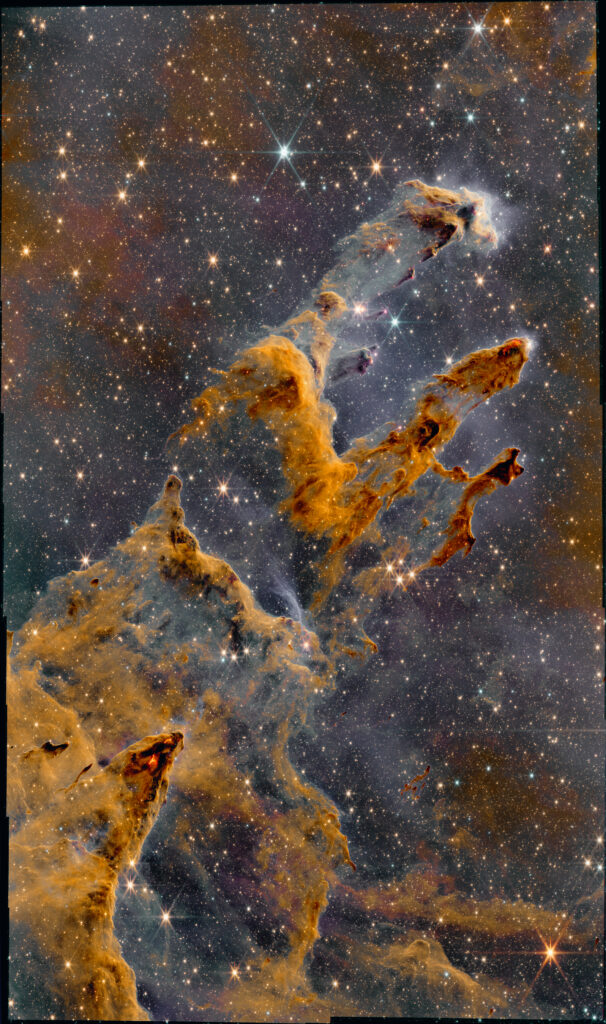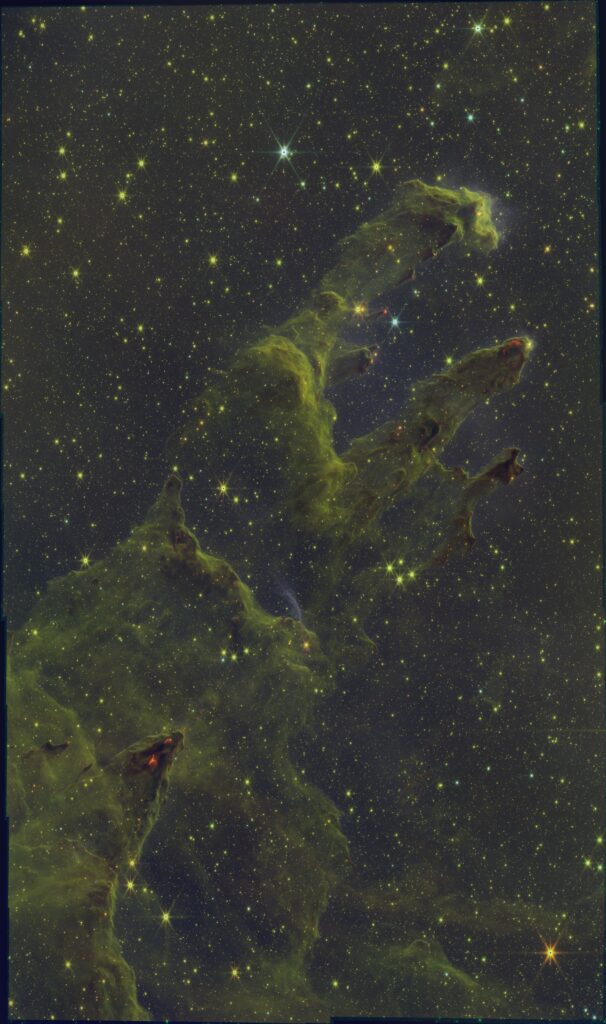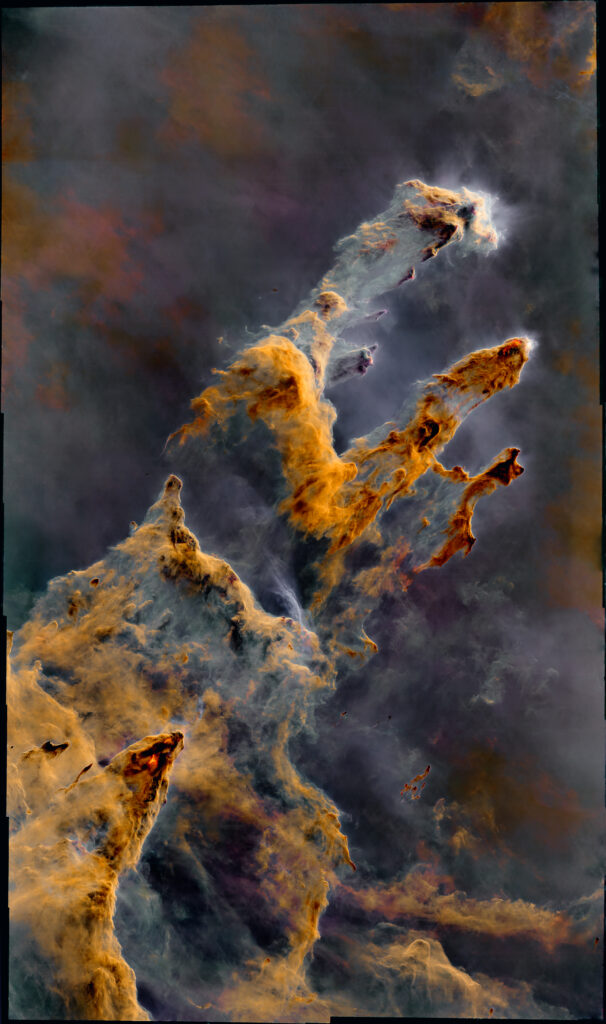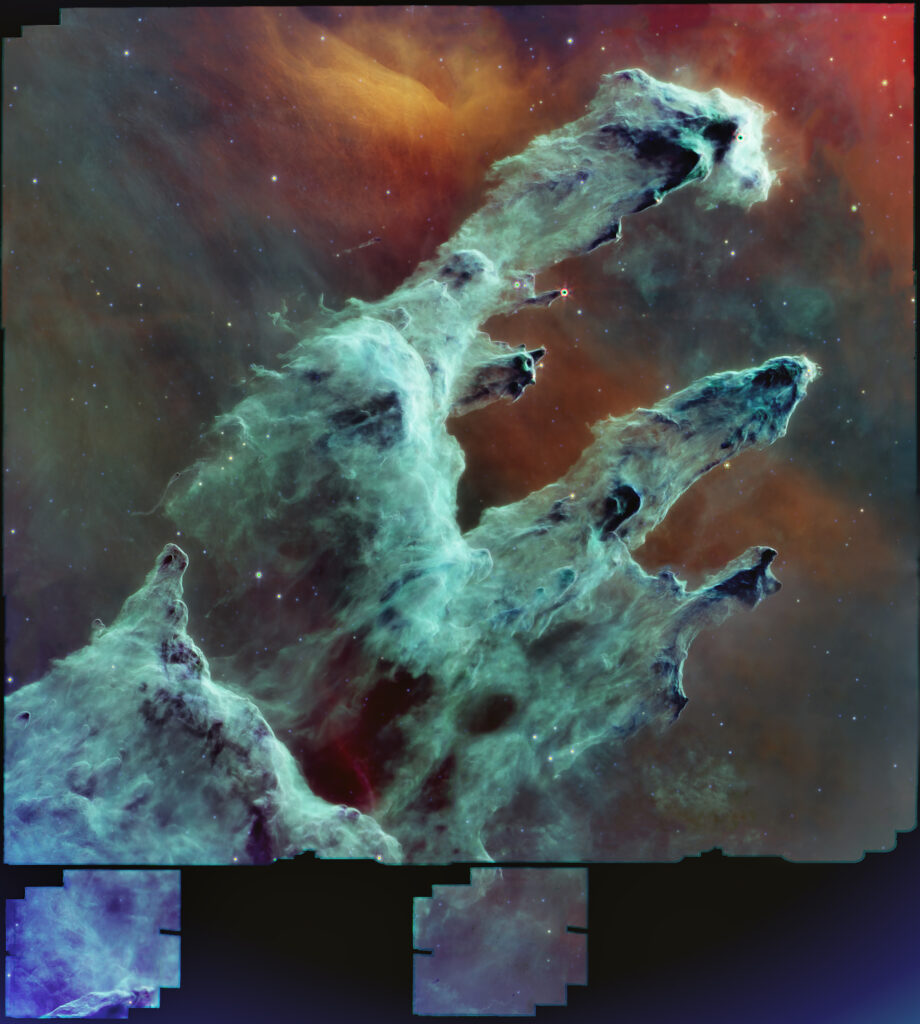M16 (NGC 6611) and the Pillars of Creation: a James Webb Space Telescope records study

According to Greg T. Bacon of the Space Telescope Science Institute of Baltimora [ https://webbtelescope.org/contents/media/videos/1097-Video 20/07/2023 ] stars cluster belonging to M16 consist in a group of around 8.000 formed roughly 5.5 milion years ago, immersing within a cloud of gas and dust illuminated by the central cluster of bright youngest new formed stars.
The Pillars of Creation sit inside this wide region of gas and dust being pushed from the inside out by powerful stellar winds.
The winds blow back the edges of the cloud, creating dense regions that then collapse under their own gravity to form stars.
The characteristic fingers of the Pillars are some of the densest gas in this region, hanging on against the strong winds.
In the visible-light view they are entirely in shadow: such visible-light gazing shows the illumination of the inside of the gas and dust.
James Webb scope focused about the iconic Pillars of Creation, immense towers carved out of the cold dust by high-energy electromagnetic radiation emitted by the hot stars.
Webb NIRCAM eye investigating the pillars of gas and dust which block visible light, reveals what is under nebulosity concealing, with stars forming within them shining of infrared light through the dust-block, revealing stars forming within the pillars as well as stars far beyond; X-ray light also shines through the pillars, revealing extremely hot stars, most of which lie beyond the nebula.
NIRCAM Near-Infrared shows cooler towers and field of dust with many young stars.

MIRI records pointing at the bottom left shows the thickest regions of gas and dust, which appear light blue and dark gray-blue: there are many layers of semi-opaque gas and dust overlaying one another.
The first pillar points to the top right of the image.
There is one prominent red star, with tiny spikes at its tip.
Lower on this pillar, which forms a diagonal from bottom left to top right, there are several darker areas of dust that jut out, many with bright red stars, which appear as small red dots.
Below the top pillar are two slightly smaller, both ending in dark gray-blue regions: the second pillar has a dark arch that looks like an upside-down L halfway down, while the third pillar is set off in dark blue and gray shades.
At the bottom left is another overlapping area of gas and dust that forms a peak, but is also colored in various shades of gray and light blue.
Background of this scene is washed in shades of deep red and light red. Toward the top center, a V shape appears above the top-most pillar. At its lowest point, it is brilliant red. There are only several dozen tiny bright white and blue stars. Larger stars appear redder and are embedded in the pillars.
According to Claire Blome and Christine Pulliam – Space Telescope Science Institue of Baltimore – Mid-infrared light set such a somber, chilling mood in Webb’s Mid-Infrared Instrument (MIRI) because interstellar dust cloaks the scene, and while mid-infrared light specializes in detailing where dust is, the stars aren’t bright enough at these wavelengths to appear. Instead, these looming, leaden-hued pillars of gas and dust gleam at their edges, hinting at the activity within.
*** Processing method ***
.fits level 3 calibration raw data I downloaded from mast.stsci.edu portal.
NIRCAM set is made of 6 .fit image recording pillars by filter f090w, f187n, f200w, f335m, f444w and f444w+f470n.
After linear fit to f200w band, according to NIRCAM filters guideline, I considered f444w and f470n as the highest signal available, to be processed as red in colour mapping.
Blue mapping I assigned to the lowest band records available, thus melting f090w and f187n in PixelMath; the same for f200w and f335m melting for the middle signal green color in rgb layout.

RGB channel combination produced a greenish dominated master, processed in PixInSight by very soft bg removal, denoising workflow, starXterminator work for starless and stars separate file.
I thus focused on starless master for color manipulation by color mask and curves transformation, dark area enhancing, denoising and final blurxTerminating for details revelation.

I finally reconstructed starry image in Photoshop by screen blending mode of stars layer group over starless one, with each group adjustement and pixel-fixing independetly made.
MIRI image followed a similiar processing work, with peculiar feature of very very intense pixel fixing intervent, both in stars and starless level.

Starless image after pixel fixing and color calibration I find simply astonishing.

Starry final image reconstruction with few adjustements intervent





